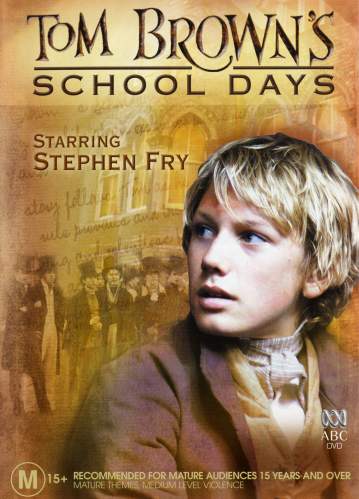Tom Brown's School Days (2005) |
|
Tom Brown's School Days (2005) |
|


|
| BUY IT |
| General | Extras | ||
| Category | Drama | Main Menu Audio | |
| Rating |

|
||
| Year Of Production | 2005 | ||
| Running Time | 93:20 (Case: 100) | ||
| RSDL / Flipper | No/No | Cast & Crew | |
| Start Up | Menu | ||
| Region Coding | 1,2,3,4,5,6 | Directed By | Dave Moore |
|
Studio
Distributor |
 Roadshow Home Entertainment |
Starring |
Stephen Fry Jemma Redgrave Alex Pettyfer Harry Michell Joe Beattie Dane Carter Clive Standen Harry Williams John Carlisle Ben Tillett Max Benitz Tom Allen Georgia Moffett |
| Case | Amaray-Transparent-Secure Clip | ||
| RPI | $29.95 | Music | None Given |
| Video | Audio | ||
| Pan & Scan/Full Frame | None | English Dolby Digital 2.0 (224Kb/s) | |
| Widescreen Aspect Ratio | 1.78:1 | ||
| 16x9 Enhancement |
 |
||
| Video Format | 576i (PAL) | ||
| Original Aspect Ratio | 1.78:1 | Miscellaneous | |
| Jacket Pictures | No | ||
| Subtitles | None | Smoking | Yes, Including pipesmoking by schoolboys |
| Annoying Product Placement | No | ||
| Action In or After Credits | No | ||
Tom Brown's Schooldays was a semi-autobiographical piece by Thomas Hughes recounting his days at Rugby School as a child of the Empire's upper middle class in the nineteenth century. The book recounts a time when it was seen as character building for the students to police themselves - leading to a Lord of the Flies-type culture where the older students bullied the younger and took all opportunities for their own liberty. Tom Brown (Alex Pettyfer) arrives as a new boy at the same time as a new headmaster (Stephen Fry doing a remarkable turn in a rare straight role) who wishes to curb the students' excess.
While Tom has trouble adjusting to the new environment and is the focus of a group of bullies led by 5th-year Flashman (played exceptionally by Joseph Beattie), the student body rebels against new rules prohibiting gambling and drinking. The morality tale that seems obvious takes a twist as Tom starts to accept the realities of school life while the headmaster's much-hated reforms barely scratch the surface of the school culture.
This 2004 version of Tom Brown's Schooldays is very much a curate's egg. Excellent performances from almost the entire cast - excepting only a couple of the younger actors - make an entertaining ninety minutes, and the look of the production is as good as might be expected from a British period piece, but the adaptation itself is wayward and leaves the viewer wondering if the wrong format was chosen along the way.
While English students will be happy to know that this telemovie addresses all the novel's major plot points, the character development feels particularly rushed and the viewer starts to feel that they don't really know the characters all that well. Subplots rocket from initiation to resolution in minutes - more to get them out of the way than to play them out - and when characters walk on only to say a handful of lines that are redolent with backstory, there's a sense that too much is trying to be crammed into a 90-minute allotment.
So would the piece have been better served as a miniseries? It's hard to say. The 1971 version with Anthony Murphy as Tom was certainly far more comprehensive and far truer to the novel, but was very much a piece of its time, and I'm not convinced that television audiences would have appreciated a Merchant Ivory-style recreation of this novel, especially given the way that the piece started to drag over the last quarter hour, looking very much as though it had run itself out too early.
That said, anyone who appreciated the novel should enjoy this adaptation, as will anyone who enjoys British character actors in full flight, but this telemovie will hardly go down as the definitive form of the work.
Remembering that this piece was filmed as a telemovie, it's hardly fair to compare its production standards to that of a major motion picture. As such, it doesn't always hold up, but the transfer itself is excellent.
Filmed for widescreen TV, this presentation is in the original 1.78:1 ratio and is 16x9 enhanced.
The film here is somewhat grainy, but in external shots this is hardly noticeable. It appears that almost every internal scene was subject to the attentions of a smoke generator and the grain shows up in the dusty atmosphere. Lines are reasonably sharp, but there is some evidence of colour bleeding around large areas of black against a white background (such as at 60:14), but again this may be caused by the excess of dust. Finally, there were several instances at which it looked as though posterisation was present, but on pausing the tape for closer examination these again appeared to have been colour shifts caused by dust diffusing the light.
Colours are highly saturated, which can look odd when contrasted to the shades of institutional grey in which the bulk of the film is cast. The director also appears to have passed on the idea of filming night-time shots of the school and the landscape and has instead recreated these effects by filming during the day, darkening the image and digitally inserting a night sky, which provides a particularly jarring colour effect.
Although the video transfer is very clean - no artefacts are to be seen - the film suffers from an odd artefact during dolly shots where there appear to be bulges on the right-hand side of the screen (this can be seen at 0:26 and 6:23, among others). This could have been the result of a poor lens used in filming.
There was no subtitle track present.
Due to the bare-bones nature of this disc, there was no RSDL change required.
| Sharpness | |
| Shadow Detail | |
| Colour | |
| Grain/Pixelization | |
| Film-To-Video Artefacts | |
| Film Artefacts | |
| Overall |
This disc had a single Dolby Digital surround track, encoded at 224 Kb/s. The presentation was clear, but could have been mixed far more skilfully.
Although there were no audio synch issues, dialogue was often muddy and seemed to fall back in the mix from time to time (such as at 43:13). This allowed it to be drowned out by the score or by background noise.
The score is good, and appropriate to the action on-screen, but is too far forward in the mix and can dominate the presentation from time to time.
The surround channels are limited to background noise, chatter and the score, and do the job that's required of them, but do not distinguish themselves in any way.
Similarly, the subwoofer was activated during the telemovie, but was not really required or noticed for good or ill.
| Dialogue | |
| Audio Sync | |
| Clicks/Pops/Dropouts | |
| Surround Channel Use | |
| Subwoofer | |
| Overall |
NOTE: To view non-R4 releases, your equipment needs to be multi-zone compatible and usually also NTSC compatible.
Unreleased in Region 1, the Region 2 version of this disc contains a history of Rugby School, production notes, a gallery and a cast filmography. In everything else it appears identical. If these features are meaningful to you, Region 2's disc is the way to go.
Although not a great adaptation, this telemovie is certainly worth watching for its performances. Despite the bare bones disc, the video and audio are fit for the task without distinguishing themselves unnecessarily.
| Video | |
| Audio | |
| Extras | |
| Plot | |
| Overall |
| Review Equipment | |
| DVD | Pioneer DV-535, using S-Video output |
| Display | Panasonic TX-86PW300A. This display device is 16x9 capable. |
| Audio Decoder | Pioneer VSX-512. |
| Amplification | Pioneer VSX-512 |
| Speakers | Wharfedale Diamond 8.3 fronts, Wharfedale Diamond 8.2 rears, Wharfedale Diamond 8 centre, Wharfedale 12" sub |